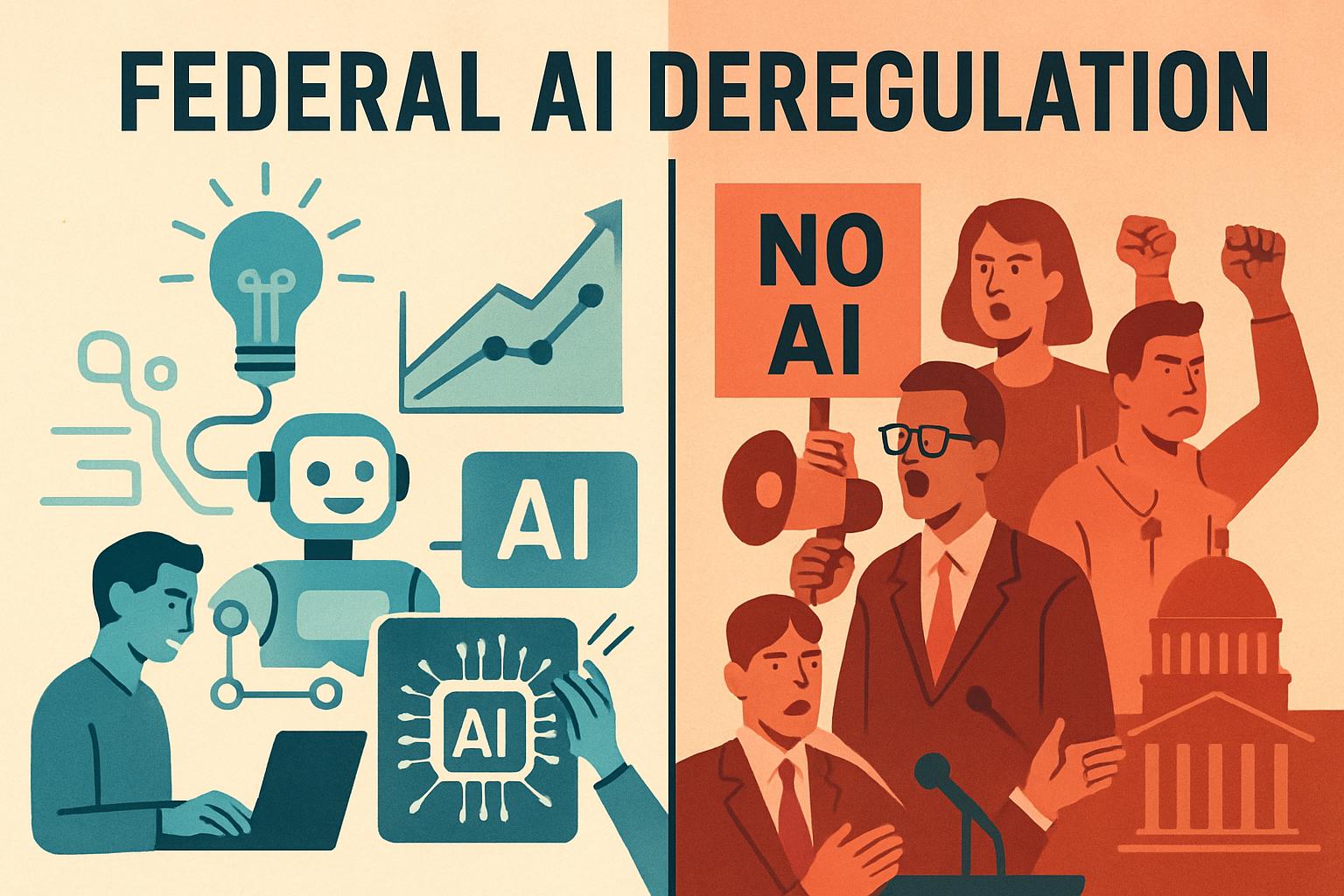
AI CERTS
4 hours ago
Federal AI Deregulation Sparks Nationwide Policy Clash
However, the plan arrives only months after the Biden order rescission that erased the 2023 safeguards. Moreover, officials frame the change as necessary innovation acceleration. Meanwhile, critics warn that unfettered growth may erode protections. Nevertheless, the debate now dominates legislative calendars and boardroom strategies.

Therefore, executives from cloud giants praise the streamlined compliance path. In contrast, state attorneys general argue the federal AI deregulation campaign sidelines local oversight. Additionally, energy analysts foresee surging electricity demand from AI data centers. The stakes, economic and environmental, could not be higher.
Federal Policy Shift Overview
The January Executive Order titled “Removing Barriers to American Leadership in Artificial Intelligence” revoked the previous administration’s directive. Subsequently, agencies received 180 days to purge rules deemed burdensome. Agencies must deliver public status updates every quarter.
July's Action Plan expanded the mandate with roughly 90 initiatives across three pillars. Furthermore, officials linked future research grants to state regulatory alignment, effectively rewarding permissive jurisdictions.
Officials present the strategy as innovation acceleration in action. Moreover, they claim federal AI deregulation unlocks faster model deployment and supply-chain investment.
These directives cement Washington’s deregulatory intent and reshape agency priorities. However, Congress remains a decisive battleground for broader authority.
Congressional Pushback Dynamics Explained
The House inserted a 10-year block on state AI rules within a May budget bill. Consequently, the measure attempted sweeping federal preemption by stealth. The clause aimed to silence future state experimentation.
Dozens of state attorneys general and 260 legislators protested the maneuver. In contrast, industry witnesses like Sam Altman endorsed the moratorium as essential for private sector leadership.
The Senate reacted decisively, stripping the clause by a 99-1 vote on July 1. Nevertheless, the episode signaled how far proponents may push federal AI deregulation during negotiations.
Legislators exposed the legal limits of reconciliation-based preemption. Therefore, attention shifted toward infrastructure and permitting levers.
Driving Infrastructure Buildout Pressures
Data demand fuels urgency. Berkeley Lab projects U.S. data-center consumption could double by 2028, reaching up to 580 TWh.
- 2014: 58 TWh data-center load
- 2023: 176 TWh, 4.4% of U.S. electricity
- 2028 projection: 325-580 TWh, up to 12% share
Therefore, the Action Plan urges expedited permits for data centers, chip fabs, and power lines. Moreover, draft NEPA exclusions would slash review times. Fast approvals could compress project timelines from years to months.
Supporters argue rapid builds embody innovation acceleration and export promotion of American hardware. However, environmental advocates fear unchecked sprawl.
Energy infrastructure now defines the frontline of federal AI deregulation. Consequently, every kilowatt saved or delayed carries policy weight.
Permitting rules could determine the plan’s success more than statutes alone. Meanwhile, lobbying efforts intensify around these technical dockets.
Evolving Industry Lobbying Landscape
Over 500 firms registered AI lobbying activity in 2025, doubling 2023 totals. Additionally, trade groups emphasize harmonized standards over fragmented mandates.
Microsoft and Google tout export promotion benefits if equipment faces fewer compliance delays abroad. Executives cite global market windows that narrow quickly. Conversely, labor unions press for safety clauses.
Corporate leaders highlight private sector leadership as the engine for global advantage. Subsequently, they link capital outlays to predictably light oversight.
The coalition’s messaging repeatedly cites federal AI deregulation as the cornerstone of competitiveness. Nevertheless, public trust issues linger.
Lobbyists will keep shaping technical language across agencies and trade offices. In contrast, state coalitions prepare counter-campaigns.
Escalating State-Level Resistance Campaign
California, New York, and Illinois already draft algorithmic fairness statutes. Furthermore, bipartisan attorneys general threaten litigation against forced preemption. Local communities fear water stress near new campuses.
Advocacy groups argue that innovation acceleration can coexist with accountability regimes. However, they claim the current blueprint ignores discrimination risks.
State lawmakers also question the Biden order rescission that erased earlier transparency rules. Consequently, they seek guardrails before large-scale rollouts.
Opposition frames federal AI deregulation as an overreach that compromises local democracy. Nevertheless, compromise proposals may emerge.
States possess substantial enforcement tools despite preemption attempts. Therefore, their stance influences corporate site selection and compliance planning.
Broader Global Competitiveness Stakes
White House officials argue the United States must outpace China’s spending. Moreover, export promotion features prominently in diplomatic briefings.
Supporters contend private sector leadership will drive allied adoption of American standards. Allies also weigh data-protection rules when choosing suppliers. In contrast, critics warn allies favor balanced regulation.
Consequently, the administration links security cooperation funds to partner openness toward federal AI deregulation narratives.
International forums now debate whether lighter rules or shared safeguards best secure trust. Meanwhile, commerce ministries track permit timelines.
Competitiveness discussions shape trade deals and research exchanges. Subsequently, domestic policy choices echo across embassies and boardrooms.
Likely Policy Pathways Forward
Observers expect the White House to prioritize agency rule changes over broad statutes. Additionally, funding incentives will nudge states toward alignment. Observers predict multiple rulemakings across commerce, energy, and defense agencies.
Meanwhile, narrower bills could address data privacy, bias testing, and export promotion without sweeping preemption clauses.
Professionals can enhance their expertise with the AI Policy Maker™ certification. Moreover, such credentials position leaders to navigate federal AI deregulation debates.
Organizations that cultivate private sector leadership skills will stay agile amid shifting requirements. Nevertheless, vigilant monitoring of the Federal Register remains vital.
The lingering effects of the Biden order rescission still ripple through agency guidance. Consequently, future administrations might revisit those revoked safeguards.
Policy watchers anticipate iterative shifts rather than one decisive statute. Therefore, staying informed ensures compliance and strategic advantage.
In conclusion, federal AI deregulation remains the defining axis of American technology policy. However, its trajectory hinges on congressional compromises, agency rules, and state pushback. Furthermore, the Biden order rescission, infrastructure urgency, and export promotion goals intertwine complex incentives. Consequently, leaders should track permit reforms, funding conditions, and global negotiations. Professionals seeking deeper insight may pursue the AI Policy Maker™ credential to influence outcomes. Ultimately, informed engagement will determine whether innovation acceleration proceeds responsibly or invites backlash.



